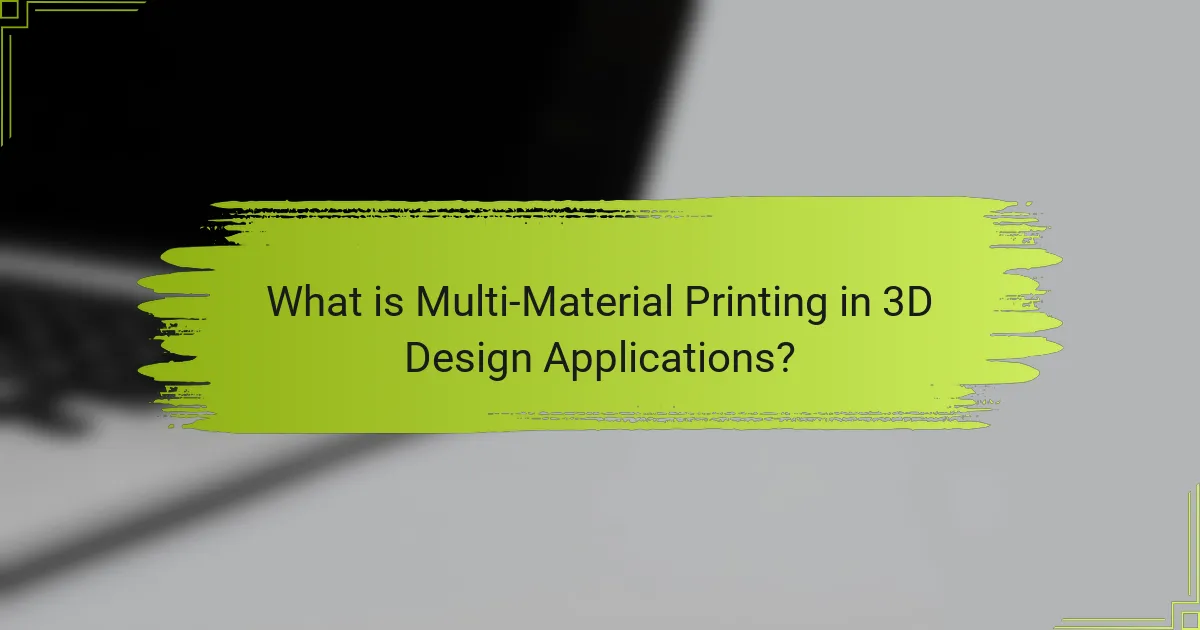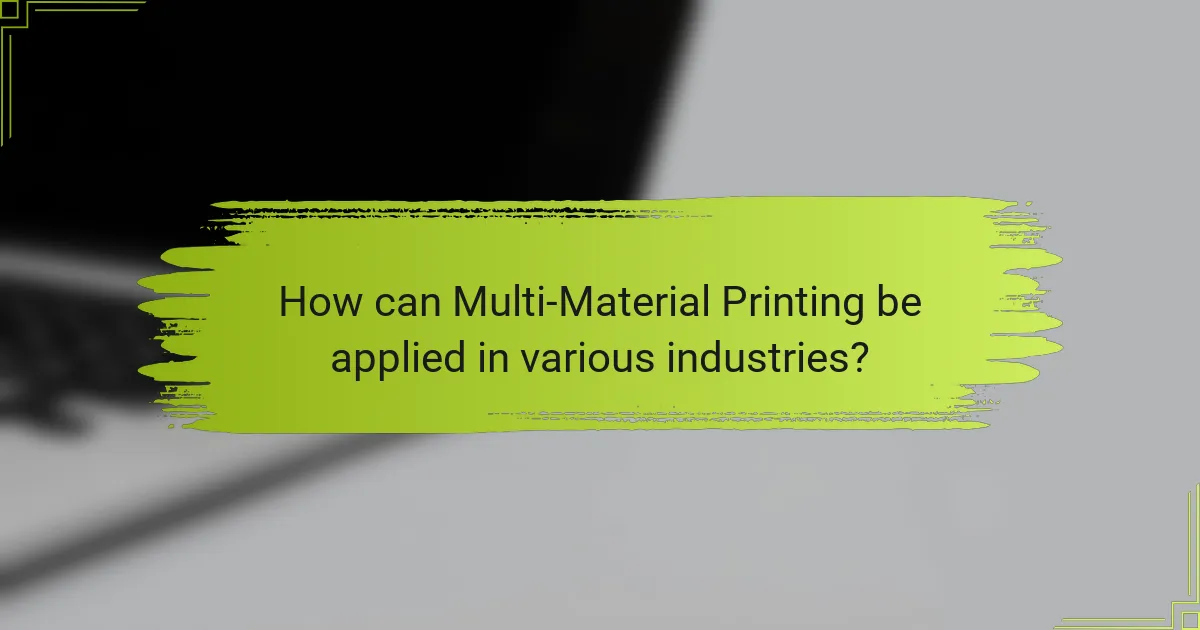
What is Multi-Material Printing in 3D Design Applications?
Multi-material printing in 3D design applications refers to the process of using multiple materials in a single print job. This technique allows for the creation of complex geometries and functionalities that single-material prints cannot achieve. Multi-material printing enables the combination of different properties, such as flexibility and rigidity, in one object. For instance, a printed item might have a rigid core and a flexible outer layer. This capability enhances the design possibilities for engineers and designers. Multi-material printing also improves the aesthetic qualities of the final product. It allows for varied colors and textures within a single print, leading to more visually appealing designs. This technology is increasingly used in industries like automotive, aerospace, and healthcare. The versatility of multi-material printing supports innovation in product development and prototyping.
How does Multi-Material Printing differ from traditional 3D printing?
Multi-Material Printing differs from traditional 3D printing by allowing the use of multiple materials in a single print job. Traditional 3D printing typically uses one material at a time, limiting design complexity. Multi-Material Printing enables the combination of different materials with varying properties. This results in parts that can have flexible and rigid sections within the same object. The technology supports enhanced functionality and aesthetics in printed items. For example, it can integrate conductive materials for electronics or soft materials for ergonomic designs. This capability opens new avenues for innovation in product development and prototyping.
What are the key technologies used in Multi-Material Printing?
Key technologies used in Multi-Material Printing include Fused Deposition Modeling (FDM), PolyJet, and Selective Laser Sintering (SLS). FDM extrudes thermoplastic materials through a heated nozzle, allowing for the combination of different materials. PolyJet uses inkjet technology to layer photopolymers, enabling high-resolution multi-material parts. SLS employs a laser to fuse powdered materials, creating complex geometries with varying material properties. These technologies enable diverse applications in 3D design, enhancing functionality and aesthetics.
What materials can be used in Multi-Material Printing?
Multi-material printing can utilize a variety of materials. Commonly used materials include thermoplastics, elastomers, and composites. Thermoplastics like PLA, ABS, and PETG provide structural strength. Elastomers such as TPU offer flexibility and durability. Composites can combine different materials for enhanced properties. Some printers also support metals and ceramics for specialized applications. The versatility of these materials allows for complex designs and functional prototypes.
Why is Multi-Material Printing important in modern design?
Multi-material printing is important in modern design because it allows for the creation of complex and functional objects. This technology enables designers to combine different materials with varying properties in a single print. For instance, flexible and rigid materials can be used together to enhance product functionality. This capability leads to more innovative designs that meet specific user needs. Additionally, multi-material printing can reduce assembly time and costs by producing parts that would traditionally require multiple components. Research indicates that products made with multi-material techniques often exhibit improved performance and durability. Therefore, the integration of multi-material printing in design processes is crucial for advancing product development.
How does it enhance design flexibility?
Multi-material printing enhances design flexibility by allowing the integration of different materials within a single object. This capability enables designers to create complex geometries and functional gradients. For example, a part can be rigid in some areas while flexible in others. This adaptability meets diverse performance requirements and aesthetic preferences. Additionally, it reduces the need for assembly by combining multiple functions into one print. Studies have shown that multi-material printing can decrease production time and costs by streamlining the manufacturing process. This approach is particularly beneficial in industries such as aerospace and healthcare, where customized solutions are essential.
What role does it play in innovation and prototyping?
Multi-material printing plays a crucial role in innovation and prototyping by enabling the creation of complex geometries and functional prototypes. It allows designers to combine different materials with varying properties in a single print. This capability enhances design flexibility and accelerates the development process. Multi-material printing facilitates rapid iteration, allowing for quick modifications based on testing and feedback. Research shows that this method can reduce prototyping time by up to 50%. Additionally, it supports the production of more realistic prototypes that better simulate final products. This realism aids in stakeholder presentations and market testing. Overall, multi-material printing significantly advances the capabilities of 3D design applications.

What are the Benefits of Multi-Material Printing?
Multi-material printing offers enhanced design flexibility and allows for the creation of complex geometries. This technique enables the integration of different materials in a single print. It supports varying material properties, such as flexibility and rigidity, within one object. Multi-material printing can reduce assembly time by producing parts that would traditionally require multiple components. It also allows for innovative designs that combine aesthetics and functionality. This method is ideal for prototyping, as it can accurately mimic final product characteristics. Additionally, it can improve product performance by optimizing material use for specific applications. Studies indicate that multi-material printing can lead to significant advancements in industries like aerospace and healthcare.
How does Multi-Material Printing improve product functionality?
Multi-Material Printing enhances product functionality by allowing the integration of diverse materials in a single print. This capability enables the creation of complex geometries with varying mechanical properties. For example, softer materials can be combined with rigid structures to produce flexible components. Products can achieve better performance through tailored material properties, such as improved durability or weight reduction. Additionally, Multi-Material Printing facilitates the design of multi-colored items, enhancing aesthetic appeal. It also reduces assembly time by combining multiple parts into one print. According to a study by Wohlers Associates, this technology can significantly streamline production processes and improve overall product efficiency.
What advantages does it provide in terms of durability?
Multi-material printing in 3D design applications offers enhanced durability through improved material properties. This technology allows the combination of various materials, each selected for specific attributes. For instance, rigid materials can be paired with flexible ones, resulting in products that resist wear and tear. The integration of materials can lead to structures that absorb impact better than single-material designs. Additionally, multi-material prints often exhibit superior resistance to environmental factors like moisture and temperature fluctuations. Studies show that products created with this method can last longer and perform better under stress. For example, hybrid materials used in automotive parts demonstrate increased longevity compared to traditional manufacturing methods.
How does it enable complex geometries and designs?
Multi-material printing enables complex geometries and designs by allowing the combination of different materials in a single print. This capability facilitates the creation of intricate structures that would be impossible with traditional single-material methods. For example, varying material properties can be utilized to optimize strength, flexibility, and aesthetics in one object. The ability to print with multiple materials simultaneously allows for advanced features like embedded components or varying densities. Research has shown that multi-material printing can produce designs with complex interlocking parts that function seamlessly together. Additionally, this technology supports the fabrication of customized products tailored to specific user needs, enhancing design versatility. Overall, multi-material printing expands the creative possibilities in 3D design, making it a powerful tool for engineers and designers.
What cost benefits can be realized through Multi-Material Printing?
Multi-Material Printing can realize significant cost benefits by reducing material waste and lowering production costs. This printing method allows for the combination of different materials in a single print, optimizing resource use. By using only the necessary amount of each material, companies can minimize excess waste, which is a common issue in traditional manufacturing.
Additionally, Multi-Material Printing can streamline the production process. It often eliminates the need for assembly of multiple parts, which can save labor costs and time. According to a study by Wohlers Associates, companies utilizing advanced 3D printing techniques, including Multi-Material Printing, have reported cost savings of up to 70% in certain applications.
Furthermore, the ability to prototype directly with final materials can reduce the number of iterations needed, leading to further savings in both time and resources. Overall, Multi-Material Printing presents a cost-effective solution for modern manufacturing challenges.
How does it reduce material waste?
Multi-material printing reduces material waste by optimizing the use of different materials in a single print. It allows for precise placement of materials where needed, minimizing excess. This targeted approach decreases the volume of unused or excess material generated during production. For instance, traditional 3D printing often requires support structures that are later removed, leading to waste. In contrast, multi-material printing can integrate support within the design, eliminating the need for additional materials. Studies show that this method can reduce waste by up to 30% compared to conventional techniques. Therefore, multi-material printing enhances efficiency while conserving resources.
What are the implications for production efficiency?
Multi-material printing enhances production efficiency by reducing material waste and speeding up the manufacturing process. This technology allows for the simultaneous use of different materials, optimizing resource utilization. According to a study by the University of Illinois, multi-material printing can decrease production time by up to 50%. Additionally, it enables the creation of complex geometries that traditional methods cannot achieve, further streamlining production. The integration of various materials in a single print reduces the need for assembly, which saves labor costs. Overall, multi-material printing significantly improves the efficiency of production workflows in 3D design applications.

How can Multi-Material Printing be applied in various industries?
Multi-material printing can be applied in various industries such as aerospace, automotive, healthcare, and consumer goods. In aerospace, it enables the production of lightweight components with complex geometries. The automotive industry benefits from creating prototypes and functional parts that combine different materials for enhanced performance. In healthcare, multi-material printing allows for the development of custom prosthetics and implants tailored to individual patients. Consumer goods manufacturers use this technology to create multi-functional products that integrate different materials for improved usability. Each application demonstrates the versatility and efficiency of multi-material printing in meeting specific industry needs.
What industries are currently utilizing Multi-Material Printing?
The industries currently utilizing Multi-Material Printing include aerospace, automotive, healthcare, and consumer products. Aerospace companies use this technology for lightweight components and complex geometries. Automotive manufacturers employ it for prototyping and production of intricate parts. In healthcare, Multi-Material Printing is used for custom prosthetics and surgical models. Consumer product companies leverage it for creating diverse textures and functionalities in their goods. These industries benefit from improved design flexibility and enhanced performance characteristics.
How is it transforming the automotive sector?
Multi-material printing is transforming the automotive sector by enabling the production of lightweight, complex components. This technology allows manufacturers to combine different materials in a single print, optimizing strength and weight. For example, using both rigid and flexible materials in one component can enhance performance and reduce assembly time. According to a study by the National Institute of Standards and Technology, this approach can reduce vehicle weight by up to 30%. Lighter vehicles lead to improved fuel efficiency and lower emissions. Additionally, multi-material printing accelerates prototyping processes, allowing for rapid iterations and design improvements. This shift enhances innovation and reduces time-to-market for new automotive models.
What impact does it have on medical device manufacturing?
Multi-material printing significantly enhances medical device manufacturing. It allows for the creation of complex geometries and customized designs. This technology enables the integration of different materials with varying properties. For instance, soft and hard materials can be combined in a single device. This results in improved functionality and patient comfort. A study by the Journal of Medical Devices highlights that multi-material printing can reduce production time by up to 50%. Additionally, it supports rapid prototyping, facilitating faster innovation in medical devices. Overall, multi-material printing leads to better performance and efficiency in medical device manufacturing.
What future trends can we expect in Multi-Material Printing?
Future trends in multi-material printing include increased material diversity and improved printing speeds. Innovations are leading to the development of new materials that can be combined for enhanced functionality. For instance, researchers are exploring the use of biodegradable materials alongside traditional plastics. This shift aims to address environmental concerns while maintaining performance. Additionally, advancements in printer technology are expected to reduce production times significantly. Studies indicate that faster printing processes can enhance productivity in manufacturing settings. Integration of smart materials that respond to environmental changes is also anticipated. These materials could enable the creation of adaptive structures in various applications. Overall, the future of multi-material printing looks promising with ongoing technological advancements.
How might advancements in technology shape its applications?
Advancements in technology will significantly enhance the applications of multi-material printing in 3D design. Improved printing techniques will allow for greater precision and complexity in designs. Enhanced materials will enable the creation of stronger, lighter, and more versatile products. Innovations in software will streamline the design process, making it more user-friendly. Automation in printing processes will reduce production times and costs. Integration with artificial intelligence will optimize design choices based on performance data. These advancements will expand the potential applications across industries such as automotive, aerospace, and healthcare. For example, multi-material printing can create customized prosthetics tailored to individual patients, improving comfort and functionality.
What are the potential challenges facing Multi-Material Printing?
Multi-material printing faces several potential challenges. One significant challenge is material compatibility. Different materials may not bond well, affecting the structural integrity of the printed object. Another challenge is the complexity of the printing process. This complexity can lead to increased failure rates during production. Additionally, achieving consistent quality across multiple materials can be difficult. Variations in material properties may result in inconsistent performance. The cost of multi-material printers and materials can also be prohibitive. High initial investment may deter adoption in smaller businesses. Lastly, post-processing requirements can be more demanding. Additional steps may be necessary to achieve the desired finish and functionality.
What best practices should be followed for effective Multi-Material Printing?
Effective multi-material printing requires careful planning and execution. First, ensure proper material compatibility. Different materials must adhere well to each other. Next, optimize print settings for each material type. Adjust temperature, speed, and layer height accordingly. Additionally, use a reliable slicing software that supports multi-material configurations. This software can help manage the print process efficiently. Regularly maintain and calibrate the printer to ensure consistent quality. Finally, conduct test prints before full-scale production. This practice can identify potential issues early on. Following these best practices enhances the overall quality and success of multi-material prints.
Multi-material printing is a 3D design technique that utilizes multiple materials in a single print job, allowing for the creation of complex geometries and enhanced functionalities. This method differs from traditional 3D printing by enabling the integration of materials with varying properties, such as flexibility and rigidity, within one object. The article explores the key technologies, materials, and benefits of multi-material printing, highlighting its significance in modern design and its applications across various industries, including aerospace, automotive, and healthcare. It also discusses how this technology improves product functionality, reduces material waste, and enhances production efficiency.